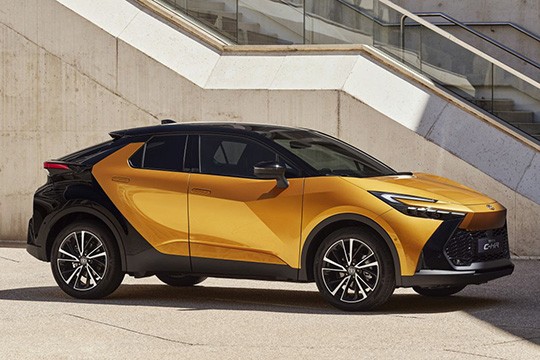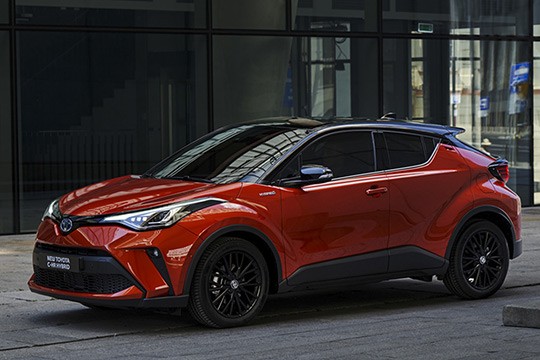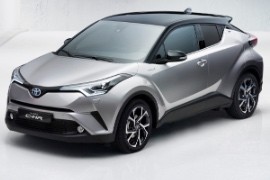TOYOTA C-HR Models/Series Timeline, Specifications & Photos
First production year: 2016
Engines: Hybrid gasoline, Plug-in hybrid, Gasoline, Hybrid
Body style: SUV (Sports Utility Vehicle)
Toyota launched the second generation of the C-HR crossover in the summer of 2023, and despite the fact that the car's overall design looked similar to the old one, it was an entirely new vehicle.
When Toyota introduced the first C-HR in 2016, it actually came late to the party. At that time, there were already many other carmakers that offered similarly-sized vehicles. But the Japanese automaker used that time to create a better product, and in a way, it did that. The car was designed well, had fuel-efficient engines, and it looked fresh. It still had its drawbacks in terms of comfort, but the second generation of the C-HR solved most of them or at least improved them.
The vehicle's exterior kept the original shape of its predecessor, but the design was drastically improved. At the front fascia, Toyota installed slim, C-shaped LED headlights. The front bumper was massive, sporting the main trapezoidal grille on its lower side. In addition, it also featured a pair of fog lamps, available either as standard or as an option, depending on the trim level. From its side, the most significant change was for the door handles that were retractable and flush with the bodywork. Finally, at the rear, the raked-forward tailgate had the taillights integrated into its vertical side. Unfortunately, that led to a massive rear fascia dominated by plastic panels and a fake grille on the bumper. Overall, the car looked sportier than before, and thanks to the new color options that allowed customers to create a two-tone paint job, it proved that it aimed at students and young couples. The previous C-HR looked more like a vehicle designed for young parents.
Inside, the biggest difference for the vehicle was the 12.3” infotainment unit that ran the latest Toyota Entune system and supported Apple CarPlay and Android Auto connectivity. In addition, the automaker also offered a digital instrument cluster. The driving position was still the same as on the 2016 model since customers liked it. In the back, on the other hand, things were not significantly improved. Still, there were bigger windows for the rear doors, and a fixed glass roof was also available, improving the interior light.
But the biggest change for the C-HR was found under its skin. Just like its predecessor, it was available with a hybrid system but with an option for a two-liter, 198 PS (195 HP) drivetrain. In addition, the automaker also provided the C-HR with a plug-in hybrid version that put out up to 223 PS (220 HP) sent to the front wheels only via an E-CVT gearbox. Those who still wanted an all-wheel-drive version of the C-HR could get the 1.8-liter hybrid drivetrain that provided a total output of 140 PS (138 HP). This model also used a continuously variable transmission gearbox.
TOYOTA C-HR 1.8L CVT FWD (140 HP)
Top seller in the C-SUV segment, Toyota CH-R received a new and improved version for the 2020 model.
The new 2020 Toyota CH-R retained its original values and look, but added some spice in the engine department. The initial 1.8 liter unit remained, but it received a better lithium-ion battery. The 122 HP kept the same basic values for performances, but for those who ask for more, Toyota now offers e new 2.0 liter poweplant which produces, with the addition of electric motor, a total of 184 HP.
The new hybrid system can reach 44 MPG (5.3 l/100 km) fuel consumption. This engine won't receive the new lithium-ion battery, but the older NiMH (nickel-metal hybrid) which was used before on the 1.8 liter engine. CH-R can be ordered with a small 1.2 liter turbo engine that delivers 116 HP which can be mated to a 6-speed manual gearbox or a CVT. On the inside, the biggest step is related to the HMI (Human Machine Interface) of the multimedia system. Toyota offers an app for either Android or Apple users which communicate better with the driver.
For the sound system, Toyota installed a new JBL developed sound system promising a hall-like sound experience. With 800 W thru 8-channel amplifier, it promises a close to CD sound even from compressed files.
For 2016, the CH-R was the Toyota’s take on the crossover market, successfully combining a coupe-like design with a high driving position - CH-R was the acronym for the Coupe High Rider.
The CH-R was ultra-modern both inside and outside. The cabin was fitted with a futuristic central touchscreen that controlled almost everything, while the uncluttered dashboard was easy to use.
Soft materials with touchy feel finishes were used throughout the cabin and the supportive seats offered great comfort.
A small downside was represented by the low rear visibility generated by the rear pillars. With the small windows in the back, the rear cabin did not have an airy feeling and not much light could get inside.
Some might have been easily tricked by the exterior look and considered the back seats did not offer enough legroom or headroom, however, the CH-R was a spacious car. The back seats could not accommodate very tall passengers due to the limited headroom, however, average people would sit comfortably with more than enough space.
The cargo area was not the best in the class, with a capacity of only 377 liters. While the rear seats could be folded, they could not be folded to the same level as the cargo mat, thus we could not say they folded flat to allow easy storage of bigger items.
Fitted with a comfortable suspension, the CH-R handled bumpy roads pretty well. However, the AWD version was stiffer than the 2WD one.
The steering was light enough for easy manoeuvring around town and precise enough to perform well on the open road.
Overall, the CH-R was an enjoyable car to ride with a distinctive, stylish exterior look.


